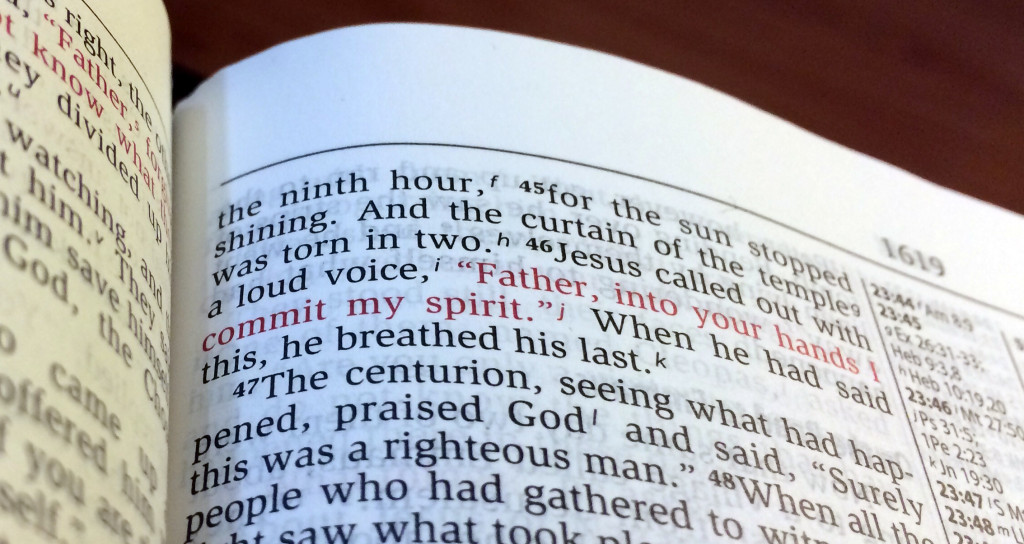The Black Letter Gospel – Miracles
In some Bibles the words of Jesus are printed in red. These “red letter” bibles are well meaning, encouraging us to consider Jesus’ teaching by drawing attention to his words, but it’s also a bit of a misleading thing. It implies that the red letters somehow hold more authority as the “Word of God” and that the black letters are somehow less important. Nothing could be farther from the truth…
Back in July, I posted on Facebook this question: “What do you think is the best way to clearly explain the gospel (the message that is at the heart of Christianity)? If you’re not a Christian, what would be the most helpful way that it could be explained, if you ever wanted to get your head around it?” My cousin posted a great response that I took as a wonderful challenge. He wrote: “I’d love to see something based on Jesus’ actions, with contextual discourse. As opposed to the usual focus on what he said.” It was a wonderful insight and revealed to me how many people hear Christians talking about Jesus.
Sometimes, we can focus on Jesus as simply a moral teacher. Jesus said this, Jesus said that. It all nice to hear someone talk, but what did he DO? How did he live? Did his actions back up his words? What can we learn about Jesus and his message and his mission, from what he did rather than what he taught? It’s a great challenge. It encourages us to look at the black letters, not just the red. Well, this four-part blog is a summary of my thoughts on that topic.
 A word of caution: Now, as much as the old saying, “actions speak louder than words” is very true, I will not completely ignore Jesus words in my exploration of his actions. If someone suddenly gives you a slap on the head, the words they say next might be vitally important. If they say, “You’re an idiot!” then you know the intention behind the action. But if they say, “You had a spider crawling on your head!” you might respond with thanks rather than a punch in the nose. Likewise, Jesus’ actions sometimes can be confusing or easily misinterpreted and so his words of explanation can be very insightful.
A word of caution: Now, as much as the old saying, “actions speak louder than words” is very true, I will not completely ignore Jesus words in my exploration of his actions. If someone suddenly gives you a slap on the head, the words they say next might be vitally important. If they say, “You’re an idiot!” then you know the intention behind the action. But if they say, “You had a spider crawling on your head!” you might respond with thanks rather than a punch in the nose. Likewise, Jesus’ actions sometimes can be confusing or easily misinterpreted and so his words of explanation can be very insightful.
Ok, now there’s lots that could be said about Jesus’ actions and it’s pretty hard to go through each one (as wonderful an exercise as that may be), so I’ve summarised them under four categories: MIRACLES, MEALS, DEATH & RESURRECTION. You might be able to find many actions that he did that don’t exactly fit under these categories, but when it comes to the most significant actions recorded in the gospels, I’d say these four pretty much cover them all.
In this first of four blog posts, we will look at: Miracles.
MIRACLES
Possibly the most memorable actions that Jesus is known for is the miracles he performed. Ask the average guy on the street and he might remember the stories about how Jesus turned water into wine, healed people, fed the 5,000 and walked on water. But what were his miracles all about? Were they like super powers that he used when he saw someone is trouble?
Well, the word that is often used alongside (or instead of) the word “miracles” is the word “signs”. The apostle Peter, when he summarises the life of Jesus before his crucifixion, says: “Jesus of Nazareth was a man accredited by God to you by miracles, wonders and signs, which God did among you through him, as you yourselves know.” (Acts 2:22) In fact, in the New Testament, supernatural actions are called “signs” around three times more often than they are called “miracles”.
The reason why Jesus’ miracles are called “signs” is because they weren’t simply super powers on display. They were a sign pointing to or SIGNifying something. Jesus’ miracles were deliberate demonstrations of the authority and identity of Jesus. They showed that he was from God.Â
You see this very clearly throughout the gospels. In John 3:2, when Nicodemus the Jewish religious ruler met with Jesus, he says: “Rabbi, we know that you are a teacher who has come from God. For no one could perform the signs you are doing if God were not with him.” When Jesus calms a storm with his word in Mark 4:35-41, his disciples are terrified and wonder, “Who is this? Even the wind and the waves obey him!” Also, when John the Baptist was in prison and starting to lose faith about whether Jesus was who he said he was, Jesus pointed to his miracles as proof. Read the following passage from Luke 7:18-23…
“John’s disciples told him about all these things. Calling two of them, he sent them to the Lord to ask, ‘Are you the one who is to come, or should we expect someone else?’ When the men came to Jesus, they said, ‘John the Baptist sent us to you to ask, ‘Are you the one who is to come, or should we expect someone else?’’ At that very time Jesus cured many who had diseases, sicknesses and evil spirits, and gave sight to many who were blind. So he replied to the messengers, ‘Go back and report to John what you have seen and heard: The blind receive sight, the lame walk, those who have leprosy are cleansed, the deaf hear, the dead are raised, and the good news is proclaimed to the poor. Blessed is anyone who does not stumble on account of me.'”
Jesus’ saw his own miracles as signs that pointed to the fact that he truly was “the one who is to come”.
 The very first public miracle that Jesus performed is probably his most famous – turning water into wine at the wedding at Cana. You can read the whole story in John 2:1-12. Now, you may think that Jesus may have done this miracle in order to help out the thirsty wedding guests or the bride and groom who were embarrassed by running out of booze, but the text says something different. It says in verse 11, “What Jesus did here in Cana of Galilee was the first of the signs through which he revealed his glory; and his disciples believed in him.” The point and purpose of the sign was to reveal his glory, and the response Jesus expects is for us to believe in him. This is the point of all the miracles, as John writes at the end of his gospel account: “Jesus performed many other signs in the presence of his disciples, which are not recorded in this book. But these are written that you may believe that Jesus is the Messiah, the Son of God, and that by believing you may have life in his name.”
The very first public miracle that Jesus performed is probably his most famous – turning water into wine at the wedding at Cana. You can read the whole story in John 2:1-12. Now, you may think that Jesus may have done this miracle in order to help out the thirsty wedding guests or the bride and groom who were embarrassed by running out of booze, but the text says something different. It says in verse 11, “What Jesus did here in Cana of Galilee was the first of the signs through which he revealed his glory; and his disciples believed in him.” The point and purpose of the sign was to reveal his glory, and the response Jesus expects is for us to believe in him. This is the point of all the miracles, as John writes at the end of his gospel account: “Jesus performed many other signs in the presence of his disciples, which are not recorded in this book. But these are written that you may believe that Jesus is the Messiah, the Son of God, and that by believing you may have life in his name.”
The miracles are supposed to be a signpost pointing to the identity of Jesus. Jesus performed them to show us that he has divine authority over nature, over sickness, over evil and over death. He is God in human form and we should respond to him as such. But how should we respond to someone who is demonstrating the authority of God? How should we respond to God?
Well, when Peter first saw Jesus perform a miracle, his response wasn’t joy or amazement – it was fear for his own soul. In Luke 5:1-11, after Jesus has just caused a miraculous amount of fish to be caught by Peter, it says, “When Simon Peter saw this, he fell at Jesus’ knees and said, ‘Go away from me, Lord; I am a sinful man!'” Peter knew he was in the presence of God his Creator – the one who was holy and perfect, the one who knew the darkness of his heart and the one who one day would judge all the world. This is the response that the miracles should inspire – A deep awareness of our own sinfulness before a holy God. It should inspire repentance.
This is what Jesus expected. You see that in Matthew 11:20-24 where Jesus rebukes the people who had seen lots of his miraculous signs: “Jesus began to denounce the towns in which most of his miracles had been performed, because they did not repent. ‘Woe to you, Chorazin! Woe to you, Bethsaida! For if the miracles that were performed in you had been performed in Tyre and Sidon, they would have repented long ago in sackcloth and ashes.'”Â
So the miracles of Jesus show us that Jesus is more than a mere moral teacher – he is God in human form. Those, like Peter, who are honest with themselves do not find Jesus’ miracles good news. When God shows us that means that you and I will be held accountable for our sin. The expectation of Peter is that Jesus has come to bring God’s wrath.
Well, Peter was right to respond to Jesus with fear of being condemned. But Jesus does something spectacular. In Luke 5:10, Jesus responds by saying “Do not be afraid” and by inviting Peter to follow him. That’s how Jesus responded to sinners. He doesn’t run away in disgust or turn away in anger, like Peter thought he would. In fact, he draws near and extends the offer to follow him. This actually a simple definition of what it means to be a Christian – someone who knows they are a sinner, but believes in Jesus and takes up his offer to follow him.
Jesus, even though he was our Creator in human form, did not come to condemn sinners. He came to welcome them and call them to repent and come back into friendship with God. This offer to sinners of mercy and reconciliation is demonstrated no more powerfully than by the second category of Jesus actions – meals.
Post on “Meals” coming soon…
Please ask your questions about this post or make a comment below.
(3647)

